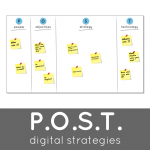Post-Digital transformation is about our own personal view of the digital transformation of companies with people at the core of the process. Post-digital is the term to pinpoint the human-centered approach in the digital era, full of technologies and gadgets. Post-digital assumes that the digital era has already arrived and we need to move towards a more genuine and human approach, pivoting our strategies not around the gadget/platform of the moment, but around the human behaviors that will remain to be relevant in the future.
An organizational transformation is not easy and has to be taken strategically, not from the tactical level. We use our proprietary 10 steps approach to the Post-Digital Transformation of your business, always pivoting from the human perspective without losing sight of your business objectives and the market trends.
|
1. Focus on your customers.In an ever-changing world, you should pivot from what really matters: your consumers, markets, their needs, and how to create value for them. |
2. People is the key, not technology.We often get distracted by the technological advances of our era, but the key to a successful transformation is the people within your organization. Always remember, at the end people will operate whatever technology you embrace. Focus on them!. |
3. Strategy, then execution.It’s easy to identify non-strategic people or vendors in your environment. They will start the conversations by offering (or asking for) an specific platform or technology, without really having clear what they need or what they will do with it. Strategies are elegant and simple, and do not change overnight. In our fast changing world, strategies are more about a dinamic trajectory than a fixed positioning. Do you already know where you want to go? |
4. It’s all about value, not gadgets.In order to be relevant among your markets, you need to understand their needs and focus on creating value for them. What problems do they have? How can you enhance something in their lives? It’s not about Unique Selling Propositions anyomore. Welcome to the era of the Unique Value Propositions! |
5. Make it step by step.Once you define you trajectory, you need to plan the digital transformation of your company based on SMART objectives: Specific (what), Measurable (why), Achievable (how), Responsible (who) and Timeframed (when). Let’s make things happen in an organized and trackable way. |
6. Think big, act small.Transformations are scary, specially when you are currently running your business. But you’re not supposed to stop your operations, nor throw all your money on unvalidated hypothesis. You need to think always in the big picture, but act small, piloting your value hypothesis in a small scale to test them true, or false. |
7. Measure everything.Everything is measurable in the digital world. Everything! So you need to establish the best strategies to gather all the data you can from your pilots, and validate your hypothesis. ROI doesn’t mean Return On Investment anymore. We are in a new world based on the Return Of Information. |
8. Fail fast & learn.Failure is an essential part of innovation and change. If 9 out of 10 hypothesis you have will turn out to be wrong, you need to be prepared to shut them down and learn everything you can from them. No hard feelings: innovation is a matter of vulnerability. Dare to fail, do it fast, and move on. |
9. Go beyond communications.A common mistake in digital transformation is to think that it’s only a matter of digital communications channels. But marketing is way beyond communications, it’s a matter of the relationships with your value chain, embracing new value creation and production paradigms, new distribution channels, understanding the habits of your offline & online shoppers, creating new platforms, challenging your business models, and understanding how to serve your customers using all the available resources you can, in the most strategic and elegant way. |
10. Being digital is inevitable.The most important think to bear in mind: being digital is not an option and, if you haven’t yet, you need to start NOW. Embrace your digital-transformation in this post-digital era. |









